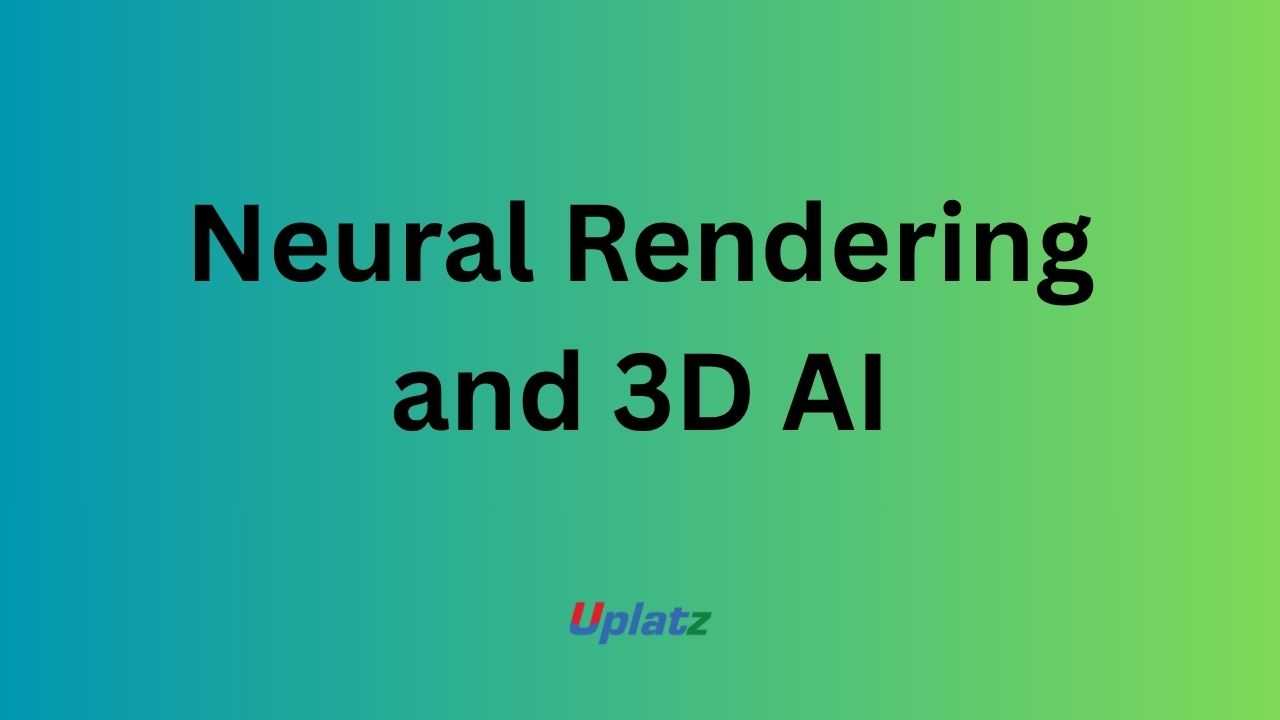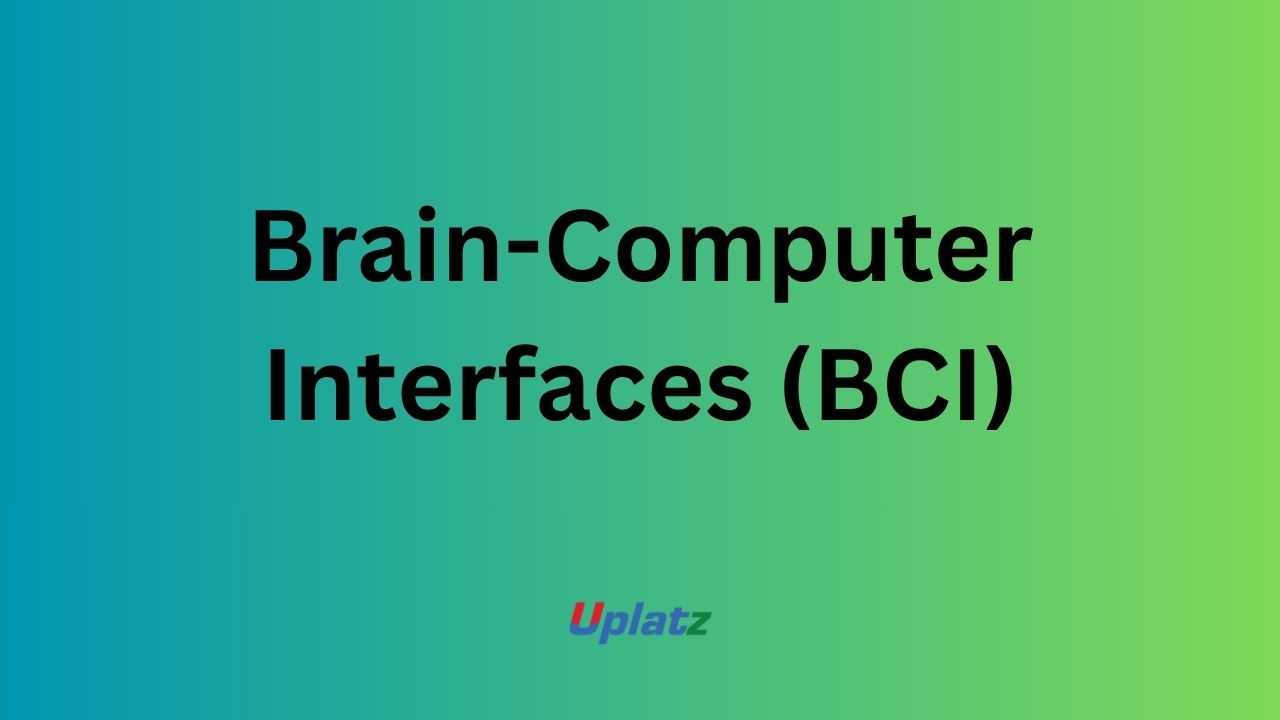Neural Rendering and 3D AI
Combine Deep Learning and Computer Graphics to Create Realistic 3D Worlds and Digital Humans Price Match Guarantee
Full Lifetime Access
Access on any Device
Technical Support
Secure Checkout
Course Completion Certificate
Price Match Guarantee
Full Lifetime Access
Access on any Device
Technical Support
Secure Checkout
Course Completion Certificate
 97% Started a new career
BUY THIS COURSE (
97% Started a new career
BUY THIS COURSE (GBP 12 GBP 29 )-
 86% Got a pay increase and promotion
86% Got a pay increase and promotion
Students also bought -
-
- Digital Twins and Simulation
- 10 Hours
- GBP 12
- 10 Learners
-

- Brain-Computer Interfaces (BCI)
- 10 Hours
- GBP 12
- 10 Learners
-

- Green AI: Sustainable & Efficient AI Development
- 10 Hours
- GBP 12
- 10 Learners

Neural Rendering and 3D AI represent the next major evolution in computer graphics, blending cutting-edge deep learning with traditional rendering techniques to create photorealistic, dynamic, and fully data-driven 3D environments. From generating digital humans to reconstructing entire scenes using a single camera, Neural Rendering is rapidly transforming industries including gaming, VFX, metaverse development, virtual production, architecture, digital twins, and simulation engineering.
The Neural Rendering & 3D AI Course by Uplatz provides an end-to-end learning journey into this revolutionary domain. You will explore how neural networks learn geometry, textures, lighting, motion, and physics to generate 3D scenes that were previously impossible or extremely expensive to create using conventional graphics pipelines. Through a combination of theory, demonstrations, and hands-on projects using PyTorch3D, NeRF Studio, Blender AI plugins, and NVIDIA Omniverse, you will learn to build neural avatars, reconstruct real spaces, model digital twins, and create AI-powered animation workflows.
This course is designed for artists, developers, engineers, and researchers who want to master the emerging field of AI-driven 3D content creation and virtual world generation.
🔍 What Is Neural Rendering?
Neural Rendering is the fusion of computer graphics, computer vision, and deep learning, where neural networks are used to render, reconstruct, or synthesize 3D content from data such as images, videos, or 3D scans. Rather than manually modelling geometry and lighting, neural techniques use learned representations — built from millions of visual samples — to generate scenes that look natural, consistent, and photorealistic.
Key elements include:
-
Neural Radiance Fields (NeRFs) for synthesizing 3D scenes from 2D images
-
Implicit 3D representations for smooth surfaces and continuous geometry
-
View synthesis models that generate new camera perspectives
-
Generative models (GANs, VAEs, Diffusion) for animation, textures, and style transfer
-
Volumetric rendering driven by neural features
-
Neural avatars & digital humans that mimic identity, movement, and expression
Neural rendering replaces rigid polygon-based methods with flexible, data-driven intelligence — leading to more dynamic and realistic results.
⚙️ How Neural Rendering Works
Neural Rendering relies on deep learning models that learn the relationships between images, depth, materials, and lighting. Instead of explicitly modelling every geometry piece, neural networks learn latent 3D structures directly from visual data.
1. Scene Representation
Models encode geometry and appearance into:
-
Radiance fields
-
Signed distance fields (SDFs)
-
Implicit neural surfaces
-
Point clouds or voxel grids
2. View Synthesis
Neural networks predict the appearance of a scene from unseen viewpoints — enabling smooth camera motion, fly-throughs, and VR experiences.
3. Neural Rendering Pipeline
-
Capture images or video
-
Estimate depth, normals, and lighting cues
-
Train a neural representation (e.g., NeRF)
-
Render novel views and dynamic scenes
4. Generative 3D AI
GANs, VAEs, and diffusion models enhance realism by generating textures, human expressions, lighting effects, and 3D shapes.
5. Simulation & Animation
AI drives motion, deformation, physics-aware animation, and avatar creation.
The course guides you through this entire workflow and teaches you to create 3D content using neural-driven methods.
🏭 How Neural Rendering Is Used in the Industry
Neural Rendering is reshaping multiple industries, creating demand for professionals skilled in AI-generated graphics.
1. Film, VFX, and Virtual Production
-
AI-assisted environment reconstruction
-
Deepfake-quality face synthesis
-
Virtual sets and camera-free scenes
2. Gaming
-
Neural avatars
-
Realistic character models
-
AI lighting and texture generation
3. Metaverse & Virtual Worlds
-
Photorealistic 3D assets
-
Immersive environments for AR/VR
-
Generative digital humans
4. Architecture & Digital Twins
-
Recreating buildings or spaces from smartphone photos
-
Immersive virtual walkthroughs
5. Robotics & Simulation
-
3D scene understanding for navigation & manipulation
-
Synthetic training data for AI models
6. Medical Imaging & Scientific Visualisation
-
Volumetric reconstructions
-
3D modelling from MRI/CT images
Industries like Epic Games, Pixar, NVIDIA, Adobe, Meta Reality Labs, Google DeepMind, and Autodesk are investing heavily in neural rendering technologies — creating strong demand for skills in this domain.
🌟 Benefits of Learning Neural Rendering & 3D AI
Mastering neural rendering equips you with next-generation creative and technical capabilities:
-
Create photorealistic 3D scenes with minimal manual modelling
-
Reconstruct spaces from simple camera inputs (ideal for digital twins)
-
Build AI-driven avatars, characters, and animation pipelines
-
Generate 3D assets automatically using generative models
-
Work with industry-leading AI graphics tools such as NeRF Studio and PyTorch3D
-
Develop valuable cross-disciplinary expertise in graphics, vision, and AI
-
Boost employability in VFX, gaming, metaverse, robotics, architecture, and simulation design
-
Future-proof your skillset as AI-driven graphics becomes standard industry practice
This course helps you transition into high-demand roles in 3D AI, neural graphics, visual computing, and generative media.
📘 What You’ll Learn in This Course
(This is the high-level landing-page overview. Syllabus sits in a separate tab.)
You will explore:
-
Basics of 3D computer graphics & computer vision
-
Neural scene representations: NeRF, SDFs, implicit surfaces
-
Generative models: GANs, VAEs, and diffusion for 3D content
-
AI-based view synthesis and photorealistic rendering
-
3D reconstruction from 2D images and video
-
Lighting, shadows, textures, and material modelling with AI
-
Neural avatars, digital humans, and motion synthesis
-
Tools: Blender AI plugins, NeRF Studio, PyTorch3D, NVIDIA Omniverse
-
Simulating and rendering AI-built environments
-
Capstone project: Build a neural-rendered 3D scene or digital avatar
🧠 How to Use This Course Effectively
To get the most out of your learning journey:
-
Start with fundamentals of vision, geometry, and 3D graphics.
-
Study neural representations: shapes, textures, materials, and radiance fields.
-
Follow practical coding sessions using Omniverse, PyTorch3D, or NeRF Studio.
-
Implement NeRF models to reconstruct scenes from 2D images.
-
Explore GANs and diffusion models to enhance realism.
-
Simulate scenes and render results in Blender or Gazebo-like environments.
-
Complete the capstone by building a neural-rendered scene, avatar, or digital twin.
-
Revisit advanced modules to refine your visual results and efficiency.
👩💻 Who Should Take This Course
This course is ideal for:
-
3D Artists & Visual Effects Professionals
-
Game Developers & Metaverse Creators
-
AI and Machine Learning Engineers
-
Robotics & Simulation Engineers
-
Computer Vision Researchers
-
Digital Twin & Virtual Production Teams
-
Students exploring 3D AI and neural graphics
-
Anyone interested in AI-driven creative technology
Only basic Python is required; no prior 3D modelling experience is needed.
🚀 Final Takeaway
Neural Rendering and 3D AI are transforming how digital worlds, characters, environments, and simulations are created. The Uplatz Neural Rendering course equips you with the models, tools, and creative workflows needed to build high-fidelity 3D content using artificial intelligence.
By the end of the course, you will understand how to combine deep learning with computer graphics to reconstruct scenes, synthesise views, generate realistic assets, and bring virtual worlds to life — unlocking powerful opportunities in entertainment, engineering, metaverse development, and scientific visualisation.
-
Understand the fundamentals of 3D graphics and AI integration.
-
Learn neural rendering pipelines and 3D data processing.
-
Implement NeRFs and volumetric rendering algorithms.
-
Apply GANs and diffusion models to texture and shape generation.
-
Build neural avatars and photorealistic simulations.
-
Use AI for view synthesis and dynamic lighting.
-
Integrate tools like PyTorch3D, Blender, and Omniverse.
-
Create 3D datasets for AI-driven rendering.
-
Develop real-world applications in games, film, and virtual reality.
-
Prepare for careers in graphics engineering, creative AI, and metaverse technologies.
Course Syllabus
Module 1: Introduction to Neural Rendering and 3D AI
Module 2: 3D Computer Vision and Geometry Fundamentals
Module 3: Neural Radiance Fields (NeRF) – Theory and Implementation
Module 4: Volumetric Rendering and Implicit Representations
Module 5: Generative Models for 3D – GANs, VAEs, Diffusion Networks
Module 6: Texture, Lighting, and Realistic Scene Reconstruction
Module 7: Tools and Frameworks – PyTorch3D, Blender, Omniverse
Module 8: Neural Avatars and Digital Human Modelling
Module 9: Applications – Metaverse, Film, Architecture, and Robotics
Module 10: Capstone Project – Build a Neural Rendered 3D Scene
Upon successful completion, learners receive a Certificate of Completion from Uplatz, validating their expertise in Neural Rendering and 3D AI. This Uplatz certification demonstrates your proficiency in integrating deep learning, 3D geometry, and computer vision to create highly realistic digital experiences.
The certification aligns with the growing demand in gaming, film production, architecture, AR/VR, and metaverse development, equipping professionals with future-ready 3D AI skills.
Holding this certification establishes you as a creative technologist capable of building visually stunning and intelligent 3D environments — transforming imagination into digital reality.
Neural Rendering Engineers and 3D AI Specialists are in rising demand across multiple industries. Completing this course from Uplatz prepares you for roles such as:
-
3D AI Engineer
-
Neural Rendering Developer
-
Metaverse Environment Designer
-
AI Graphics Programmer
-
Visual Computing Researcher
Professionals in this field typically earn between $110,000 and $200,000 per year, depending on their domain and creative expertise.
Career opportunities span film studios, AR/VR startups, gaming companies, robotics labs, and metaverse enterprises, where 3D AI drives immersive storytelling, simulation, and design. This course equips you to lead innovation at the crossroads of AI, visual arts, and computational creativity.
-
What is Neural Rendering?
It’s the use of AI and neural networks to generate realistic 3D scenes from visual data. -
What is a Neural Radiance Field (NeRF)?
A model that represents 3D scenes using neural networks to predict colour and light at every spatial coordinate. -
How does AI improve traditional 3D rendering?
By automating texture, lighting, and perspective generation through learned representations. -
What are key frameworks for neural rendering?
PyTorch3D, Blender, NeRF Studio, and NVIDIA Omniverse. -
What is volumetric rendering?
A technique that models how light passes through 3D volumes for realistic effects like smoke, fog, or glass. -
How are GANs used in neural rendering?
They generate realistic textures, shapes, or entire 3D models. -
What’s the difference between geometric and neural rendering?
Geometric rendering relies on explicit models; neural rendering learns implicit representations from data. -
What industries use neural rendering?
Gaming, film production, architecture, robotics, and metaverse design. -
What are common challenges in neural rendering?
High computational cost, data scarcity, and rendering time. -
What is the future of 3D AI?
AI-driven real-time rendering, 3D scene synthesis, and human–avatar co-creation in the metaverse.









